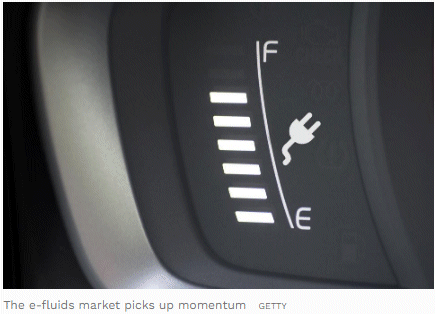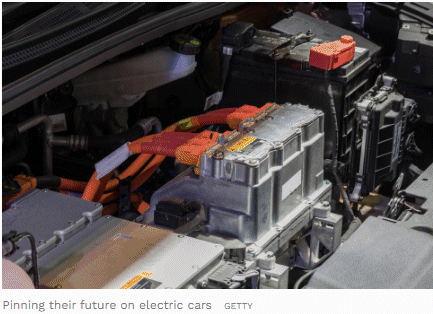Dwindling internal combustion engine (ICE) vehicle sales are affecting the hugely profitable automotive oils, fluids and lubricants industry. The demand for traditional lubricants and hydraulic fluids is plunging, leaving lubricant manufacturers and the associated aftermarket struggling to find new revenue sources. But hold off writing their obituary just yet, electrified vehicles—hybrids, electric and fuel cell powered, among them—are emerging as a vigorous new lifeline.
By 2030, one in every two cars sold globally is expected to be electrified. Not surprising then that the lubricants industry is moving to capitalize on this opportunity by diversifying into e-fluids that are advertised as enhancing EV performance, range and durability.
However, as their fortunes revive, not everyone and everything in the e-fluids market will gain equally. Which and where will these particular growth pockets be and why?
A Mixed Bag Of Offerings

E-fluids, as the name suggests, are fluids created specifically for EVs. Importantly, it is not a monolithic market with a single offering, comprising as it does three main product segments.
First are e-transmission fluids that are indicated for use only in EVs and are used in plug-in hybrids (PHEVs), battery electric vehicles (BEVs) and fuel cell EVs (FCEVs). E-greases are designed to counter noise, vibration and harness (NVH) levels within EVs. And, finally, there are e-thermal fluids that are themselves categorized into three types of thermal management solutions.
The first of these is air cooling as found in the Nissan Leaf, Toyota Prius, and Kia Soul where there is no e-thermal fluid present. The second is liquid cooling where a type of e-thermal fluid is present. These are predominantly glycol-water based solutions and are used in the Tesla Model S, Audi eTron, and BMW i3. The third category is that of immersion-based (dielectric fluids), phase change materials or oil-based solutions. These are true e-thermal fluids but are likely to experience extremely limited adoption in the next decade.
e-Thermal Fluids Get Hot
In 2019, e-fluids were still very much a niche market. In essence, the limited uptake of ‘first fill’ e-fluids meant that the subsequent demand for ‘service fill’ was virtually non-existent.
This is all set to change. A recent Frost & Sullivan study estimates that a total of nearly 40 million liters of e-transmission fluids, e-thermal fluids and e-greases will be sold across the eight countries that have the highest EV penetration levels—Germany, France, the U.K, Norway, Netherlands, China, U.S and Japan—by 2025.
Needless to say, such projections depend primarily on the overall adoption rate of e-fluids which we anticipate at around 30% for e-transmission fluids, 40% for e-greases and 60% for e-thermal or cooling fluids by 2025.
The adoption rates for e-transmission fluids and e-greases means that 30% and 40% of all EVs sold will have e-transmission fluids and e-greases, respectively, installed in them at the factory level.
Meanwhile, I believe the dominance of cooling fluids will be underpinned by the move of certain EV models from air-based cooling to liquid cooling. Among the more prominent examples include Europe’s highest-selling EV model, the Nissan Leaf, and the Honda E that will feature an active liquid cooling system from 2023 onwards. Moreover, future BEV models from Audi will have an active liquid thermal management system, while Toyota is set to adopt the active cooling strategy for its high-capacity hybrid segment post-2022.
First Fill vs Service Fill
In 2025, first fill is projected to account for more than 90% of the market with service fill making up the remainder.
The service fill potential for e-transmission fluids is estimated to be only 10% of its first fill counterpart. Europe, an early adopter of e-transmission fluids, is forecast to have the highest service fill volume potential at this point.
The service fill market for e-thermal fluids is likely to be even less at only 0.5% of the first fill market, due to first fill for life or late adoption. Revenues, limited as they are, will be generated by ad-hoc services related to accidents, battery replacements or damage and dealership warranty concerns.
E-greases will most likely not be used for service fill, since the wear and tear and collision parts for which greases are required will be pre-greased before they are factory installed in vehicles.
While the first fill market for e-fluids will scale in parallel with EV production volumes, service fill are expected to ramp up, plateau and decrease by around 2045 as a result of two counteracting trends: the increasing EV parc using e-fluids versus the extended service intervals of e-fluids negatively impacting service fill potential. In the long term, service fill volumes are expected to decline as more EV manufacturers transition to fill for life and intervals between service fill become longer.
Lubricant Companies Get Into The Action
Lubricant companies clearly anticipate strong growth for e-fluids. As EV parc grows, many are expanding their range of e-fluid offerings within their lubricant portfolio. While Shell, Castrol and Exxon Mobil already have a complete e-fluid portfolio range, Total offers e-transmission and e-thermal fluids, while Fuchs currently offers only e-transmission fluids.
Shell’s high quality e-fluid offering is based on its proprietary gas-to-liquid (GTL) technology, starting with natural gas molecules and then turning those molecules to base oils. There is no sulphur in them; pure paraffin-based, exceptionally pure base oils. Exxon Mobil offers e-transmission fluids and e-greases under better and best grades for wider market reach. The stakes are high and the competition is only set to get more intense. In June this year, JXTG (Eneos) launched into battle with six different grades of e-transmission fluids targeting Japanese and Chinese EV manufacturers.
Europe Takes The Lead
So much for the answers to which and why? As for the where? Strong EV sales push initiatives such as government subsidies of up to 20-25% for EVs will make Europe a beacon for e-fluid manufacturers. In overall terms, almost 100% adoption of e-fluids is expected in Europe post 2030, even as uptake rates in other regions will be slower.
EV juggernaut China is set to be the second highest adopter of e-fluids after Europe. This will largely be a result of the rising production levels of high performance EVs over the next five years. On the other hand, cost constraints will slow down the adoption of all three e-fluids types in Japan.
Covid-19 notwithstanding, EV sales, particularly in Europe, continue to remain strong. This contrasts with the steadily declining sales of ICE vehicles. With every indication that EV sales will continue to ramp up once economies revive, players in the e-fluids market are upbeat about their prospects. And nothing underlines this sentiment more than oil companies who are working overtime to convert their traditional lube customers into e-fluid customers in the hope of capturing a share of this rapidly developing market. A sign, perhaps, for other traditional automotive oils, fluids and lubricant manufacturers who are exploring ways to make up for the lucrative margins that the traditional ICE lubricant market once offered.
Article was originally published on Forbes.com




